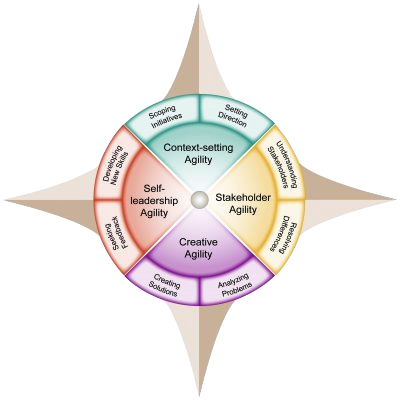

Based on the award-winning book, Leadership Agility, by ChangeWise principals Bill Joiner and Steven Josephs, The Leadership Agility 360 evaluates a manager’s level of agility in leading organizational change, improving team performance, and engaging in productive business conversations. Their in-depth research has shown that, in today’s turbulent economy, increased agility is the key to sustained effectiveness in all three of these key leadership arenas.
Pete Behrens is a Certified Leadership Agility 360 Coach.
Levels of Leadership Agility
Based on this research, we’ve created a behaviorally specific framework that identifies where managers are in their development from tactical problem-solvers into strategic managers, and then into visionary leaders. Managers develop through these three agility levels in a sequential manner, always retaining the capacities and skills they gained at previous levels:
- Expert: Individuals who operate at this level of agility use their technical and functional expertise to make tactical organizational improvements, supervise teams, identify and solve key problems, and sell their solutions to others. Research indicates that about 45% of managers operate at this level.
- Achiever: Managers who function at this level of agility use their managerial skills to set clear organizational objectives, lead strategic change, motivate and orchestrate team performance, and engage in challenging cross-boundary conversations. About 35% of managers operate at this level.
- Catalyst: Those rare managers who have developed this level of agility are visionaries who can lead transformative change, develop high participation teams, and collaborate with others to develop creative, high-leverage solutions to tough organizational issues. About 10% of managers operate at this level.
As change accelerates and the world continues to become more complex, the need increases for more Experts to become Achievers and for more Achievers to become Catalysts. The Leadership Agility 360 is a critical tool for both sizing and addressing these developmental challenges.
Developmental Framework Identifies Growth Potential
Most assessments don’t provide this instrument’s stage-by-stage developmental roadmap to higher levels of effectiveness. Because it includes the statistically rare Catalyst level, this instrument shows executives and high-potential managers, who score at the high end of most 360s, where they have room for growth — in specific, behavioral terms.
Organizational Agility requires leaders who can create and catalyze high-performing team environments.
Three Key Leadership Contexts
Based on the award-winning book, Leadership Agility, by ChangeWise principals Bill Joiner and Steven Josephs, the Leadership Agility 360 assesses a manager’s level of agility in three distinct contexts:
- Leading organizational change:initiatives to improve an organization and/or its relationship with its larger environment.
- Improving team performance: initiatives to improve a team and/or its relationship with its larger environment.
- Engaging in pivotal conversations: person-to-person discussions with important outcomes at stake.
Four Kinds of Leadership Agility
This research also identified four kinds of “agility” that are essential in making the most of any leadership initiative. The specific behaviors assessed in the Leadership Agility 360 are organized into these four arenas:
- Context-setting agility improves your ability to scan your environment, frame the initiatives you need to take, and clarify the outcomes you need to achieve. It entails stepping back and determining the best initiatives to take, given the changes taking place in your larger environment.
- Stakeholder agility increases your ability to engage with key stakeholders in ways that build support for your initiative. It requires you to step back from your own views and objectives to consider the needs and perspectives of those who have a stake in your initiatives.
- Creative agility enables you to transform the problems you encounter into the results you need. It involves stepping back from your habitual assumptions and developing optimal solutions to the often novel and complex issues you face.
- Self-leadership agility is the ability to use your initiatives as opportunities to develop into the kind of leader you want to be. It entails stepping back; becoming more aware of your thoughts, feelings, and behaviors; and experimenting with new and more effective approaches.
For more information about the Leadership Agility 360™, contact us for a detailed description about its features, benefits and cost.

